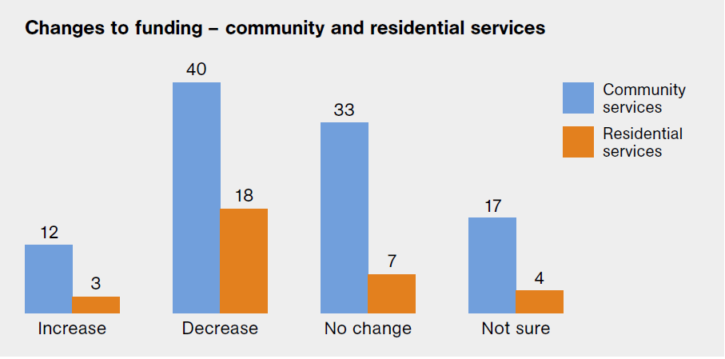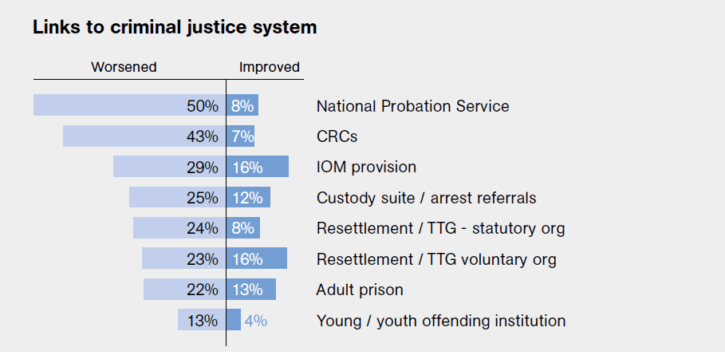More services face funding cuts
The Recovery Partnership has just (10 March 2016) published its 3rd State of the Sector report. The first two were produced by DrugScope. Following that organisation’s sad demise, the 2015 report has been produced by Adfam.
The report is based on a lengthy online survey and a series of interviews with senior figures in the sector to evaluate the experiences of drug and alcohol treatment services in England. [A survey of prison drug and alcohol services was also conducted and will be published later this month.]
176 services responded to the survey, the largest number yet. 79% of these were community services, 18% residential and the rest mutual aid and “other” services. There were representatives from all sectors: 55% respondents were from the voluntary sector, 23% NHS and 11% private.
Key findings
The findings from the report are divided into three sections: funding; commissioning cycles; and the delivery of services which are summarised in turn below.
Funding
Over three times as many community services (40 services or 38%) reported a decrease in funding compared to those reporting an increase (12 services or 11%). Of residential services, six times as many (18 or 58%) reported a decrease in funding compared to those reporting an increase (3 or 10%). A significant proportion from both categories stated ‘no change’.

Respondents were asked about how changes to funding had impacted on services. You can see the impact on both staff and service users in the graphic below:

Contract length and commissioning cycles
Survey responses suggest that in many local authorities commissioning cycles remain fairly compressed. While 14% reported their current contract was longer than their last one, 23% said the current contract was shorter.
44% of services have been through retendering or contract renegotiation in the previous year, and around half (49%) are expecting to go through retendering or contract renegotiation between September 2015 and September 2016.
Concerns were expressed that frequent retendering can be destabilising for both service users and staff, and constitute a diversion of scarce resources away from the delivery of frontline services. Some smaller providers feel they are disadvantaged in the commissioning system, owing to their relative lack of resources to devote to tendering.
Views of retendering, though, are far from universally negative. Encouragingly, considerable proportions of respondents believe that as a result of recent retendering, services: better reflect local need (40%); better reflect good practice (44%); and have prioritised quality (38%).
Service delivery
This section focuses on four key issues: complex needs; access to accommodation; links with the criminal justice system and naloxone.
Multiple and complex needs
Though not in any way a new issue for the sector, the challenge of providing joined-up support to service users with multiple and complex need, such as a ‘dual diagnosis’ of substance use and mental ill health, emerges as a prominent theme across all three annual reports. The survey as a whole paints a varied picture. A fifth of respondents feel that access to mental health provision has worsened, with only 9% reporting an improvement.
Access to housing
Access to suitable accommodation continues to be perceived as problematic. Three times as many feel that availability of housing/
resettlement services has worsened over the last year as improved (18% vs 6%). Interviewees made it clear that there are some examples of new partnerships and in-house initiatives to improve access to housing, though regional variation was emphasised in the comments and interviews,
particularly regarding access to the private rented sector.
Links to the criminal justice system
Respondents reported that links to the criminal justice system had weakened – particularly with the new split probation service, as the graphic below shows:

Naloxone
In October 2015, new legislation came into force allowing substance use services commissioned by a local authority or the NHS to supply naloxone without a prescription. The survey for this report came to early to expect to capture any significant changes. However, it was encouraging that 61% respondents felt confident that their staff have the skills, knowledge and support to engage with naloxone provision, a modest increase on the previous year (55%).
Services continued to recognise the importance of harm reduction more broadly, including among many abstinence-based residential rehabilitation services. Eighty per cent of respondents felt that harm reduction needs were met through local provision, and comments provided suggest that in some areas testing, vaccination and pathways into treatment for blood-borne viruses (BBVs) are improving. Other comments indicate that variation between local areas and services remain.
Conclusion
These are tough times for drug and alcohol treatment services — like almost all public services — and it is clear that when cuts follow cuts, the impact becomes deeper and affects core services.
Perhaps the most interesting aspect of this report is that despite a large proportion of services facing budget cuts, a similar proportion have not had cuts and a minority received increases.
It is hard to be confident that next year’s State of the Sector will not paint an even more negative picture.






